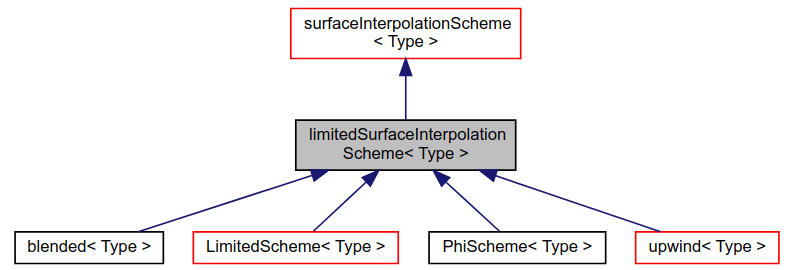#201925
FVM 方法的积分近似需要计算控制体积表面的值,通常是因为采用了 Gauss 定理,将散度转换为了对表面的积分,然后离散:
在这里,未知场是 U_f (U_f 可以是标量场,也可以代表向量场),需要对 U_f 进行离散或插值处理。上一次 Code of the Week #36: div(phi,U) Gauss linear 讲到了 linear 的离散方法,这一次我们来讲讲 upwind 差分格式。
在使用 linear 插值格式时,容易造成解的振荡。
upwind 差分格式指定是在散度项使用,其方式为
divSchemes
{
div(phi, U) Gauss upwind;
}
设 U_f 为标量场。 upwind 所表示的在面 e 上插值格式为
意思就是,当在 e 面上的通量为正 (向外) 时,e 上的 U 值取 U_P ,反之,取 $U_E$。
在 OpenFOAM 中,其类的继承关系是

(https://www.openfoam.com/documentation/guides/latest/api/classFoam_1_1upwind.html)
upwind 继承了 limitedSurfaceInterpolationScheme,它的继承关系为

(https://www.openfoam.com/documentation/guides/latest/api/classFoam_1_1limitedSurfaceInterpolationScheme.html)
limitedSurfaceInterpolationScheme 继承了 surfaceInterpolationScheme。
upwind 有三个构造函数,取其中一个:
//- Return the interpolation weighting factors
tmp<surfaceScalarField> weights() const
{
return pos(this->faceFlux_);
}
上面一段代码的意思是
注意,返回数据的类型是 surfaceScalarField.
根据继承关系,由于 upwind 并没有特别指明 corrected ,所以它还是继承了 surfaceInterpolateScheme.H 所设定的值:
//- Return true if this scheme uses an explicit correction
virtual bool corrected() const
{
return false;
}
在 surfaceInterpolateScheme.C 中,
//- Return the face-interpolate of the given cell field
// with explicit correction
template<class Type>
tmp<GeometricField<Type, fvsPatchField, surfaceMesh> >
surfaceInterpolationScheme<Type>::interpolate
(
const GeometricField<Type, fvPatchField, volMesh>& vf
) const
{
if (surfaceInterpolation::debug)
{
Info<< "surfaceInterpolationScheme<Type>::interpolate"
"(const GeometricField<Type, fvPatchField, volMesh>&) : "
<< "interpolating volTypeField from cells to faces"
<< endl;
}
tmp<GeometricField<Type, fvsPatchField, surfaceMesh> > tsf
= interpolate(vf, weights(vf)); // 根据 weights(vf) 来插值
if (corrected())
{
tsf() += correction(vf);
}
return tsf;
}
//- Return the face-interpolate of the given cell field
// with the given weigting factors
template<class Type>
tmp<GeometricField<Type, fvsPatchField, surfaceMesh> >
surfaceInterpolationScheme<Type>::interpolate
(
const GeometricField<Type, fvPatchField, volMesh>& vf,
const tmp<surfaceScalarField>& tlambdas
)
{
...
const surfaceScalarField& lambdas = tlambdas();
const Field<Type>& vfi = vf.internalField();
const scalarField& lambda = lambdas.internalField();
const fvMesh& mesh = vf.mesh();
const unallocLabelList& P = mesh.owner();
const unallocLabelList& N = mesh.neighbour();
tmp<GeometricField<Type, fvsPatchField, surfaceMesh> > tsf
(
new GeometricField<Type, fvsPatchField, surfaceMesh>
(
IOobject
(
"interpolate("+vf.name()+')',
vf.instance(),
vf.db()
),
mesh,
vf.dimensions()
)
);
GeometricField<Type, fvsPatchField, surfaceMesh>& sf = tsf();
Field<Type>& sfi = sf.internalField();
for (register label fi=0; fi<P.size(); fi++)
{
sfi[fi] = lambda[fi]*(vfi[P[fi]] - vfi[N[fi]]) + vfi[N[fi]]; // surface-interpolation caculate
}
// Interpolate across coupled patches using given lambdas
// Code moved under virtual functions into fvPatchField
// HJ, 13/Jun/2013
forAll (vf.boundaryField(), patchI)
{
vf.boundaryField()[patchI].patchInterpolate
(
sf,
lambdas.boundaryField()[patchI]
);
}
tlambdas.clear();
return tsf;
}
因此,当 U_f > 0 时,
因此,当 U_f < 0 时,